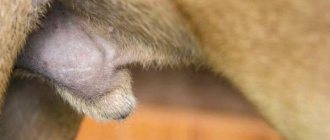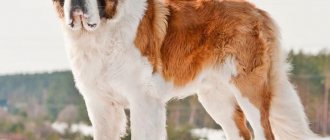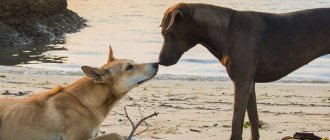Russian greyhound (weight – 36-60 kg, height – 75-86 cm)
This rating also includes representatives of the ancient Russian breed. Russian greyhounds are sophisticated and graceful creatures. Such dogs were first mentioned in documents of the 13th century. Five centuries later, greyhounds became the favorites of Russian nobles and tsars.
Strong, dynamic and light dogs could accelerate to 90 km/h, which made escape from the prey pointless. Leo Tolstoy, an avid hunter, wrote about this breed: “A dog runs with its heart, not with its legs.” Today the Russian Greyhound is one of the top 15 hunting breeds in the world.
But outside of hunting, these animals are very calm and even delicate, without intruding on the owner or even disturbing him with their barking. But in return, greyhounds expect similar politeness towards them. These dogs endure punishment very painfully. And it was the Russian greyhound that received the honor of becoming the symbol of the Russian Canine Federation.
The largest and tallest
Tibetan Mastiff: the largest pet in the world and its character traits
The largest and most massive dogs belong to the Molos group, and the championship of the tallest ones is held by Irish wolfhounds and another representative of the Molos - the Great Dane.
Mastiffs
It is in this group that some of the largest dog breeds are collected. The word mastiff itself can be translated as master or master of thieves, which tells us that these dogs are primarily used as guard dogs.
English Mastiff
A very large, heavy dog with powerful and strong bones. The ancestor of the breed is considered to be the Tibetan mastiff, who came to Britain with the Celts in ancient times. The further mixing of these dogs with the fighting dogs of the Saxons and, subsequently, the Norman hunting mastiffs laid the foundation for this breed. Purposeful selection began during the Tudor dynasty, so the second and more correct name of the breed is the Old English Mastiff.
Dogue de Bordeaux
A French dog breed with a strong, stocky build. Individual individuals can reach a weight of 90 kg. If we also take into account that the face of the Dogue de Bordeaux is called “the face of an old boxer,” then the appearance seems completely terrifying. However, for lovers there is no better or more beautiful breed than this.
Neapolitan Mastiff
A strong, brutal type dog, heavy and rough in build. The head is wide, massive, covered with wrinkled skin. He is very loyal to his owner, so he can be jealous of other family members or pets. It perfectly fulfills its task as a watchman, scaring away ill-wishers not only with its appearance. Doesn't really like strangers and treats them with great suspicion. For this dog, a spacious enclosed yard is desirable, where he can calmly realize his guard instinct.
German dog
Perhaps the most aristocratic representative from the world of large dogs, he amazes with his grace and secularity. He never barks for no reason and is not the first to show aggression. The Great Dane was bred for the purpose of hunting large game and as a guard dog. Much has changed since then and now the Great Dane is just a companion. But what! One of the smartest and noblest dog breeds, capable of lying on the sofa all day long, like a true philosopher. He is absolutely not aggressive towards other dogs or animals; the Great Dane simply tolerates them.
Saint Bernard
A majestic, good-natured and affectionate huge bumpkin. Maybe because monks were involved in the selection of St. Bernards, or maybe for another reason, the whole life of a St. Bernard is devoted to serving people. An excellent sense of smell, strong paws and claws allowed St. Bernards to find and free avalanche prisoners in the snowy mountains.
It is difficult to keep a St. Bernard in urban conditions; they are too tied to weather conditions. No, no, dogs are very hardy and can tolerate any temperature, but a cool or winter atmosphere is preferable for them. Saint Bernards are divided according to their coat type into long-haired and smooth-haired. Training a St. Bernard quickly gets boring, so it’s worth conducting initial training in a playful way.
Penile prolapse in dogs: problems and treatment
Hello, Alla.
The symptoms you described are most likely explained by paraphimosis: a too narrow preputial ring pinches the dog’s penis and prevents its natural return to its normal position.
Paraphimosis
This happens in young males after a state of excitement or in adults after mating. Usually, the penis returns to its natural state within a few minutes or hours, but in the case you are noting, paraphimosis is most likely occurring.
Inflammation of the mucous membrane
It is possible, of course, that there is simple inflammation of the genital mucosa. But in both cases, your dog will really experience not just discomfort, but real pain. They are also caused by constant, incessant tension of the genital organ, accompanied by high pressure in the blood vessels. But the dog will suffer even more from emerging cracks, microtraumas and inflammation on the skin of the penis and inflammation of the mucous membrane. The mucous membrane becomes inflamed within a few hours.
Before contacting doctors, you can carefully disinfect inflamed areas with appropriate preparations: the best and simplest antiseptics are potassium permanganate 0.5-2% solutions or 3% solution of ordinary hydrogen peroxide; after using antiseptic drugs, it makes sense to treat the wounds with ointments containing antimicrobial and anti-inflammatory components (Loriden-S, Goxizone, Dermozolon). Lubrication should be carried out 2-3 times a day.
If restoration of the normal state of the genital organ does not occur even after all the procedures described above for more than 3 days, urgently take your pet to the doctor. The dog is really suffering. The animal, apparently, needs either special treatment, the course of which can only be prescribed by a specialist, or even surgical intervention.
Prevention
From my experience I will say that such manifestations are not uncommon, especially in large breed dogs (shepherds, mastiffs). This can happen after the onset of active puberty before the first mating of a male dog (from 4 months to 1.2 - 1.5 years) or immediately after the first mating. Often such symptoms appear in hyperactive puppies, which, when excited, can imitate sexual intercourse with various objects, other dogs or even other animals. If you notice such behavior in a puppy (or a young male before mating), gently turn his attention to something else, force him (but not by shouting or hitting!) to stop such actions.
The situation is quite fixable, and you are a great fellow for paying attention to the problems of your pet. I am sure that an experienced veterinarian will undoubtedly come to the rescue!
Good luck to you in keeping and raising your pet. I hope I helped in resolving the problem.
Sincerely, Alexander.
Saint Bernard (weight – 80-100 kg, height – 70-90 cm)
What is the best dog food in 2021?
The history of this breed originates from the Swiss Alps, full of dangerous mountain passes. It is believed that in the 11th century such dogs not only guarded the monastery of St. Bernard, but also helped the monks in searching for travelers lost in the snow and fog. The name of the monastery gave its name to the breed.
The large size of St. Bernards and their dense thick fur, as well as powerful paws and an excellent sense of smell, helped the dogs find people even under a two-meter layer of snow. Thanks to their keen hearing, these dogs can hear an avalanche approaching. In 1983, research conducted by Americans showed that such a talent allows dogs to distinguish sounds with a frequency of up to 46 kHz, while the human hearing threshold is 20 kHz.
Today, these gentle and sensitive giants are rarely used as rescuers, but they feel great in families, where they quickly become friends with children. The popularity of St. Bernards grew significantly after the Beethoven film series in the 1990s.
The biggest dog in the world
Which dog has the strongest bite?
Huge is not only a dog with impressive dimensions. The giants among man's friends have repeatedly set records and impressed people with various parameters.
The tallest
The phrase “biggest” most often means the tallest dog. The title of the tallest living dog in the world as of 2022 is claimed by a Great Dane named Atlas from Florida, USA. The height at the withers of the giant dog is 104 cm. The record has not yet been confirmed by a representative of the Guinness Book of Records, but this is quite likely, because the previous holder of this title passed away in January 2021.
Spencer Seay, left, and her husband Jordan measure Atlas, a purebred Great Dane, on April 9, 2022. The dog's height is 104 cm.
The previous record holder in the category “tallest dog in the world” was the man-sized giant from England Freddie, a Great Dane.
Great Dane Freddie with his owner Claire Stoneman and a KRG certificate. The height of the dog at the withers was 103 cm.
The dog's height, recorded in 2016, when measured at the withers, standing on four legs, reaches 103 cm, but if it stands on its hind legs, this parameter increases to 230 cm, which is larger than a person of average height. Moreover, the giant weighs 90 kg. Unfortunately, after living a little over 8 years, Freddie died, but the place of the record holder is still empty.
Before Freddie, there were other tall dogs listed in the Guinness Book. The first record holder for height was a blue mastiff named George, originally from the USA, the city of Tucson. His height reached 109 cm, and his body length from tail to nose was 221 cm. He was recorded as a record holder in 2011.
Great Dane George, the height of the dog at the withers was 109 cm.
In 2013, the title of “the largest dog in the world” went to the Great Dane named Zeus from Michigan, USA, whose height was 111.8 cm. At the same time, standing on his hind legs, Zeus reached almost 2.3 m! The title of the tallest dog that ever lived still belongs to Zeus. Zeus died in 2014, but is still the largest dog in history.
The tallest dog in the world to ever live is the Great Dane Zeus. The height of the dog at the withers was 111.8 cm.
The heaviest
The “biggest” category can also include the heaviest dog. In this category, the palm belongs to the English mastiff named Zorba, who lived in London. In September 1987, he was included in the Guinness Book of Records because he weighed 140 kg. Then, in 1989, he broke his own record, setting it at 155.6 kg!
Zorba is the heaviest dog in the world that has ever lived. The dog's weight was 155.6 kg.
Zorba died in 1992, but is still the world's heaviest dog to have ever lived.
The longest
Among the largest is the longest dog in the world. The English mastiff Zorba again showed himself in this parameter. Having not only the maximum weight possible for a dog, he was included in the Guinness Book due to his length. When measuring the body from the nose to the tip of the tail, a length of 251 cm was recorded. At the same time, the height of the dog is 94 cm.
Zorba is the world's longest dog that has ever lived. The length of the dog's body from the tip of the nose to the tip of the tail was 251 cm.
The strongest
We also decided to include the record holder for strength in the largest category. The strongest dog was recognized as a representative of the St. Bernard breed - Raittes Brandy Bear from Washington, USA. This is a four-year-old pet, weighing about 80 kg, who showed impressive endurance and power in 1978, pulling a cart full of railroad tracks. The total weight of the load is 2905 kg, the distance covered by Brandy with the cart is 4.57 m, and the time spent by the dog is 90 seconds. At the same time, the dog was moving not on a slippery surface, but on concrete.
The most muscular
The dog with the most developed and voluminous muscles is considered to be the English greyhound named Whippet. She lives in Canada, on a farm in Victoria. The dog has a normal sized head and legs, and even the internal organs meet the standards for animals of this breed. At the same time, the large beauty weighs twice as much as her relatives - 27.2 kg and has huge, pressing muscles. Even on her stomach, the Whippet has 24 pack abs.
Ingrid Hansen and her whippet Wendy in 2007, when the dog attracted worldwide attention. Photo by Bruce Stotesbury, Times columnist
The appearance of the most muscular dog on the planet is due not to regular and hard physical training, but to a genetic defect. Her body had a mutation in the gene that regulates the production of the protein myostatin, which limits muscle growth. As a result, the muscles grow uncontrollably without additional effort on the part of the dog.
Scottish Deerhound (weight – 40-50 kg, height – 75-80 cm)
The first mentions of these tireless hunters can be found in medieval chronicles, and the ancestors of the breed are carved on stone slabs from the 1st century. It is believed that the owners of Scottish deer greyhounds did not even need weapons when hunting - the powerful dogs themselves drove and killed even large wild deer. This breed is distinguished by its excellent sense of smell and instant reaction; the dogs move over rough terrain without any problems.
But as soon as the hunt ends, the deerhound becomes affectionate and balanced. The dog easily remembers commands and gets along well with children. But these dogs perceive cats and other small animals exclusively as potential prey.
It must be said that the Scottish Deerhound is a very rare breed. In addition to their homeland, they are also bred in America. The slender and graceful greyhound Haikori gained fame, having twice won the most famous American exhibition - the Westminster Show. In 2007, this greyhound became the best puppy, and in 2011 - the best hunting dog.
Alabai (weight – 50-80 kg, height – 70-75 cm)
The Alabai, or Central Asian Shepherd Dog, has been serving man since very ancient times. Thus, in Turkmenistan, archaeologists found terracotta figurines of the 2nd-4th centuries, which are dedicated to large, broad-chested dogs with an impressive head. For centuries, these shepherds have protected their owners, guarded houses and herded herds. It is only outwardly that Alabai seem slow - they have a quick reaction and a difficult, stern disposition.
Alabais are also known as Turkmen wolfhounds. Today the breed is considered a symbol of this country. And in November 2022, a 15-meter gilded monument to Alabai was even erected in Ashgabat. The largest representative of the breed lives today in Russia. A shepherd named Bulldozer weighs 125 kg and eats 5 kg of meat and 10 liters of porridge per day.
Top 10 largest dogs in the world
When thinking about buying a large dog, many people carefully study the breed market, choosing the ideal option for their family.
If one of the main criteria for your choice is the size of the dog, then you should pay attention to the rating of the largest breeds
So, the top largest dog breeds in the world!
english mastiff
- English Mastiff. Due to their docile and friendly nature, representatives of this breed are often called gentle giants. This is an ancient breed of dog that lived in Ancient Babylon and was used to hunt lions. The height at the withers varies in the range of 70-91 cm, regardless of the gender of the dog. Average weight starts from 55 kg and can reach 100 kg!
- Spanish Mastiff. This breed is slightly inferior to the previous one, because the average height of such dogs is from 72 to 88 cm, and their weight ranges from 70 to 120 kg!
- Saint Bernard One of the most familiar breeds for the Russian average person. This is not only a large, but also a heavy dog, because the weight of representatives of this breed is not inferior to mastiffs and can reach 100 kg. The average height of a St. Bernard at the withers is 65-90 cm.
- Pyrenean Mastiff. The Hygina breed has been used for a long time as a herder for animals. The height of representatives of this breed is never lower than 72 cm, and for males it reaches 81 cm. Weight most often is 70-80 kg, although some mastiffs can be heavier.
- German dog. An incredibly elegant and graceful dog, the height of which in the hall is rarely lower than 8 cm, and in females - 72 cm. It is this breed that is included in the Guinness Book of Records as the tallest. With impressive growth, Great Danes have a low weight: from 45 to 90 kg.
- Tibetan mastiff. These furry inhabitants of the Himalayas also delight in their size. The height is up to 81 cm, and the weight is from 40 to 80 kg. The weight of the largest Tibetan mastiff is 112 kg.
- Newfoundler or diver. This breed is considered a faithful assistant to fishermen. She has a water-repellent coat and paws that are ideal for swimming. Due to their powerful strength, these dogs are considered excellent rescuers. The average height of a dog is from 65 to 75 cm. The representative of this breed, the female Barbara Alens Dark Hans, is considered the strongest dog, because with her own weight of 44 kg, she was able to stretch a load of almost 2300 kg.
- Boerboel. A service dog, an excellent guard dog, can reach a height of up to 70 cm and weigh 70-90 kg. This is a powerful human assistant.
- Moscow watchdog. The breed was developed in Russia. The minimum height of these dogs is 66-68 cm. Males weigh from 60 kg and above, and females look more graceful and their average weight starts from 45 kg.
- Leonberger. A large breed that was bred in Germany in the century before last. Height can reach up to 80 cm, and weight can reach 77 kg.
Moscow watchdog
The list of the largest dogs in the world would be incomplete without mentioning other large breeds, including Alabai, Neapolitan Mastiffs, Irish Wolfhounds, Hungarian Kuvasz, Caucasian Shepherd Dogs, Buryat-Mongolian Wolfhounds, Pyrenean Mountain Dogs, Komondors, Anatolian Shepherds, Russian Black Terriers , Bullmastiffs, Dogo Bordeaux, Swiss Mountain Dogs, herding South Russian Shepherd Dogs, American Akitas, Dogo Argentino, Russian Greyhounds, Cane Corsos, Deerhounds, Estrela Shepherd Dogs. The average weight of these breeds does not fall below 40 kg, and the height is 60 cm.
Diagnosis of balanoposthitis in dogs
Of primary importance in diagnosing balanoposthitis in dogs is a thorough examination of the entire foreskin and penis. Self-diagnosis may be incorrect, since you may not fully examine the affected area and understand the nature of the problem; this requires a professional examination by a veterinarian. In some cases, an otoscope or even a rigid endoscope is used for a more thorough examination during examination. In cases where the animal is uncontrollable (which can also be aggravated by soreness of the foreskin and penis), it is possible to examine and subsequently diagnose your pet under sedation. Sometimes, if a systemic infection is suspected, the doctor prescribes clinical and biochemical blood tests, as well as a urine test, which is taken by cystocentesis through a puncture in the abdominal wall (you should not be afraid of this procedure, as it is a routine procedure for most veterinary specialists). It is also necessary to conduct tests for genitourinary infections (chlamydia, mycoplasmosis and others).
Great Dane (weight – 54-91 kg, height – 80-90 cm)
The word mastiff was originally universal; in medieval Europe this was the name given to all large dogs. But this particular breed appeared in the 19th century in Germany. Experts artificially bred it from several other varieties. Great Danes proved to be both powerful and graceful. Moreover, these dogs are even taller than mastiffs. For example, in America there lived a Great Dane Zeus, who, with a height of 111 cm, weighed 70 kg.
And although Great Danes have a menacing appearance, in reality they are affectionate and obedient animals. The breed knows how to guard well, is friendly with people and successfully acts in films. You can at least remember a dog named Cyclone, who played in the Soviet film “The Hound of the Baskervilles”.
Unfortunately, Great Danes are not known for their longevity - on average they live only 6.5 years. Artificial breeding of the breed can be blamed for this. In the early 2000s, studies were conducted that showed that Great Danes, due to inbreeding and selection for external characteristics, often suffer from tumors, as well as heart and stomach diseases.
Causes of balanoposthitis in dogs
- Physical injuries and damage.
- Bacterial infections.
- Phimosis (narrowing of the foreskin, in which the penis cannot be exposed).
- Allergic reactions.
- Tumors.
- Foreign bodies between the penis and prepuce.
- Sexually transmitted viral infections.
- Mycotic (fungal) infection.
Depending on the cause and course of the disease, balanoposthitis in dogs can develop in mild or severe form. The mild form does not require extensive diagnosis and is effectively treated. A severe form can develop from a mild one in advanced cases; to determine its causes, comprehensive diagnostics and more complex treatment may be required.
Balanoposthitis is one of the most common problems in uncastrated males.
Moscow watchdog
- Height: 68-78 cm
- Minimum weight: 45 kg
The Moscow Guard is a fairly young breed of large-sized dog, which was bred in Moscow nurseries by crossing St. Bernards, Caucasian Shepherds and hounds. It turns out that when at home, the dog has the good-natured disposition of a lazy, well-fed St. Bernard, but as soon as he goes to training, he is already a ferocious “Caucasian”. The breed was specially bred for watchdog purposes, which it does with success. For all its obedience and extraordinary intelligence, the dog is distinguished by its aggressiveness, excellent reaction and endurance. She gets along well with those who are part of “her” family and is ready to protect and serve. During training, aggression towards the dog should in no way be shown, because the response will not be long in coming.
Symptoms of balanoposthitis in dogs
- Yellow-green or yellow discharge (pus) visible on the spicule of the penis or prepuce.
- Sometimes bloody discharge from the foreskin or penis.
- There may be inflammation around the penis and swelling of the foreskin.
- Your pet may be anxious.
- The dog licks the foreskin excessively.
- During mating, the male does not show interest in the female, who is in heat.
- In advanced cases, appetite decreases or is absent, and body temperature may rise.
If you notice such signs in your pet, it is very important to promptly seek professional help from a veterinarian.
Newfoundland (weight – 60-70 kg, height – 69-75 cm)
These dogs are often called divers. It must be said that strong and friendly big dogs from the Canadian island of Newfoundland are welcomed all over the world. The advantage of this breed is the complete absence of aggression and hunting instincts. These dogs cannot offend either humans or animals.
It's all about what qualities of animals were in demand in the harsh conditions of the island. Dogs with webbed feet and water-repellent coats are good swimmers. Strong dogs help people pull nets, transport cargo, and even navigate the sea. Long service to people has taught Newfoundlands a certain independence; the dogs are excellent at making decisions in extreme situations. The breed has proven to be a good companion and assistant to humans; Newfoundlands get along well with children, thanks to their endless patience.
Newfoundlands were also included in the Guinness Book of Records as the strongest dog. In 1979, Barbara Alles' dog Dark Hans, weighing only 44 kg, was able to pull a cart with a load of 2 tons.
Prevention of balanoposthitis in dogs
Prevention of the occurrence of balanoposthitis in dogs primarily includes eliminating factors of contamination of the preputial cavity. Pet owners should wash the preputial cavity after walks if there was dirt outside (wash with warm saline solution). It is also important to avoid sexually transmitted infections.
It is also recommended to visit the veterinary clinic once every three months for a preventive examination.
This article is intended for owners of dogs of large and small breeds. The purpose of this article is to familiarize owners with such a pathology as balanopastitis, for timely diagnosis and treatment of this problem and to prevent the development of complications that significantly worsen the patient’s general condition and further prognosis for recovery.











